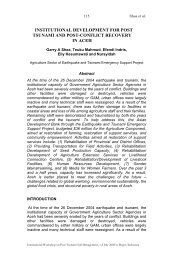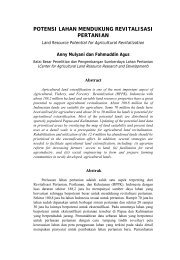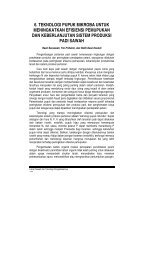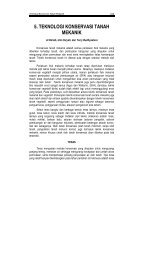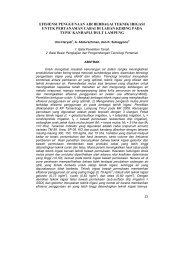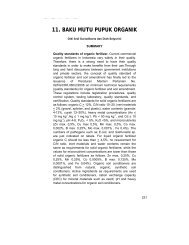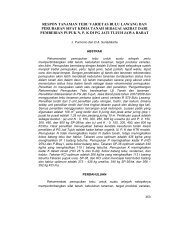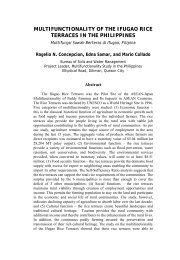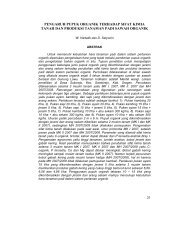- Page 2 and 3: Proceedings International Workshop
- Page 6 and 7: Ladies and Gentlemen, v We are situ
- Page 8 and 9: Ladies and Gentlemen, vii The time
- Page 10 and 11: ix sediment, soil and water salinit
- Page 12 and 13: xi TABLE OF CONTENTS FOREWORD .....
- Page 14 and 15: 1 Harjadi PJP INDONESIA TSUNAMI EAR
- Page 16 and 17: 3 Harjadi PJP Figure 3. Site distri
- Page 18 and 19: 5 Harjadi PJP The Operational compo
- Page 20 and 21: 7 Harjadi PJP National Coordinating
- Page 22 and 23: 9 Harjadi PJP • UNESCO, IOC, ITIC
- Page 24 and 25: 2.5. Buoys (BPPT) 11 Harjadi PJP Be
- Page 26 and 27: 4. Situation Center 13 Harjadi PJP
- Page 28 and 29: Figure 18. The decision support sys
- Page 30 and 31: Figure 20. Observation perspective
- Page 32 and 33: Figure 23. Five in one information
- Page 34 and 35: 21 Niino Y AGRICULTURAL IMPACTS IN
- Page 36 and 37: 23 Niino Y rehabilitation of salt-a
- Page 38 and 39: 25 Niino Y who lost their crops, li
- Page 40 and 41: 27 Niino Y damage afflicting agricu
- Page 42 and 43: 29 CONCLUSION AND RECOMMENDATIONS N
- Page 44 and 45: 31 Niino Y − Income generation th
- Page 46 and 47: 33 Abubakar and Basri REHABILITATIO
- Page 48 and 49: 35 Abubakar and Basri Table 1. Ligh
- Page 50 and 51: 37 Abubakar and Basri Table 3. Thic
- Page 52 and 53: 39 Abubakar and Basri Table 5. Padd
- Page 54 and 55:
CONCLUSIONS 41 Abubakar and Basri R
- Page 56 and 57:
43 MANAGING TSUNAMI-AFFECTED SOILS
- Page 58 and 59:
45 Slavich et al. Figure 3. Tsunami
- Page 60 and 61:
47 Slavich et al. they were not aff
- Page 62 and 63:
49 Slavich et al. factors observed
- Page 64 and 65:
51 DYNAMICS OF TSUNAMI-AFFECTED SOI
- Page 66 and 67:
53 Rachman et al. measured using th
- Page 68 and 69:
55 Rachman et al. Table 2. Characte
- Page 70 and 71:
57 Rachman et al. Figure 2. Distrib
- Page 72 and 73:
59 Rachman et al. complex are domin
- Page 74 and 75:
Soil depth (cm) B Soil depth (cm) C
- Page 76 and 77:
63 Rachman et al. empty pods. The f
- Page 78 and 79:
65 ENVIRONMENTAL RISKS OF FARMING O
- Page 80 and 81:
67 Agus F of North America, Europe
- Page 82 and 83:
International Workshop on Post Tsun
- Page 84 and 85:
IMPLICATIONS 71 Agus F Land suitabi
- Page 86 and 87:
73 Agus F Proceedings of the 12th I
- Page 88 and 89:
75 POST-TSUNAMI AGRICULTURE LIVELIH
- Page 90 and 91:
Nagapattinam Background Geographica
- Page 92 and 93:
79 Mohan GMC extensively in compari
- Page 94 and 95:
81 Mohan GMC NGOs wherever there wa
- Page 96 and 97:
83 Mohan GMC Between February’05
- Page 98 and 99:
1.7. Constraints: 85 Mohan GMC •
- Page 100 and 101:
87 Mohan GMC The successful first y
- Page 102 and 103:
89 Joshi L ACCELERATING LIVELIHOOD
- Page 104 and 105:
POVERTY AND TREE CROPS 91 Joshi L P
- Page 106 and 107:
93 Joshi L The survey conducted in
- Page 108 and 109:
CONCLUSIONS 95 Joshi L Aceh and Nia
- Page 110 and 111:
97 Sembiring et al. IMPLICATIONS OF
- Page 112 and 113:
99 Sembiring et al. level of tolera
- Page 114 and 115:
101 Sembiring et al. Leaching, soil
- Page 116 and 117:
103 Sembiring et al. Aceh Barat. Th
- Page 118 and 119:
105 Sembiring et al. lowland rice t
- Page 120 and 121:
107 Sembiring et al. and developmen
- Page 122 and 123:
109 Iskandar and Chairunas PALAWIJA
- Page 124 and 125:
111 Iskandar and Chairunas Tunong V
- Page 126 and 127:
113 Iskandar and Chairunas DPTPH Pr
- Page 128 and 129:
115 INSTITUTIONAL DEVELOPMENT FOR P
- Page 130 and 131:
117 Shea et al. Material support wa
- Page 132 and 133:
TRANSPORTATION 119 Shea et al. Duri
- Page 134 and 135:
121 Shea et al. As highlighted duri
- Page 136 and 137:
123 Shea et al. Connection Centers:
- Page 138 and 139:
125 Shea et al. Photographs: Left -
- Page 140 and 141:
127 Shea et al. Photographs: Left -
- Page 142 and 143:
MEDIA FOR WOMEN FARMERS 129 Shea et
- Page 144 and 145:
131 McLeod et al. SOIL SALINITY ASS
- Page 146 and 147:
133 Figure 1. Locations of assessme
- Page 148 and 149:
135 McLeod et al. fields after the
- Page 150 and 151:
137 Wahyunto et al. ASSESSMENT OF A
- Page 152 and 153:
139 Wahyunto et al. 2004 (before th
- Page 154 and 155:
141 Wahyunto et al. Since the major
- Page 156 and 157:
143 Wahyunto et al. Table 1. Existi
- Page 158 and 159:
145 Wahyunto et al. low fertility),
- Page 160 and 161:
147 Wahyunto et al. Table 2. Method
- Page 162 and 163:
CONCLUSIONS 149 Wahyunto et al. Lan
- Page 164 and 165:
151 Wahyunto et al. FAO. 1976. Fram
- Page 166 and 167:
153 Sammut et al. TECHNICAL CAPACIT
- Page 168 and 169:
155 Sammut et al. associated manage
- Page 170 and 171:
157 Sammut et al. Tarunamulia, 2006
- Page 172 and 173:
159 Sammut et al. Unfortunately, a
- Page 174 and 175:
161 Sammut et al. Gosavi K, Sammut
- Page 176 and 177:
163 Chairunas DEVELOPING TECHNOLOGY
- Page 178 and 179:
165 Chairunas Table 1. The average
- Page 180 and 181:
REFERENCES 167 Chairunas BPS. 2007.
- Page 182 and 183:
169 List of Participants Internatio
- Page 184 and 185:
171 Didi Ardi S., Dr. Indonesian So
- Page 186 and 187:
173 Irawan, Dr. Indonesian Soil Res
- Page 188 and 189:
175 Mulyadi, Mr Indonesian Institut
- Page 190 and 191:
177 Subhan, Mr Institute for Vegeta
- Page 192 and 193:
179 Astu Unadi, Dr. Kepala Balitkli



